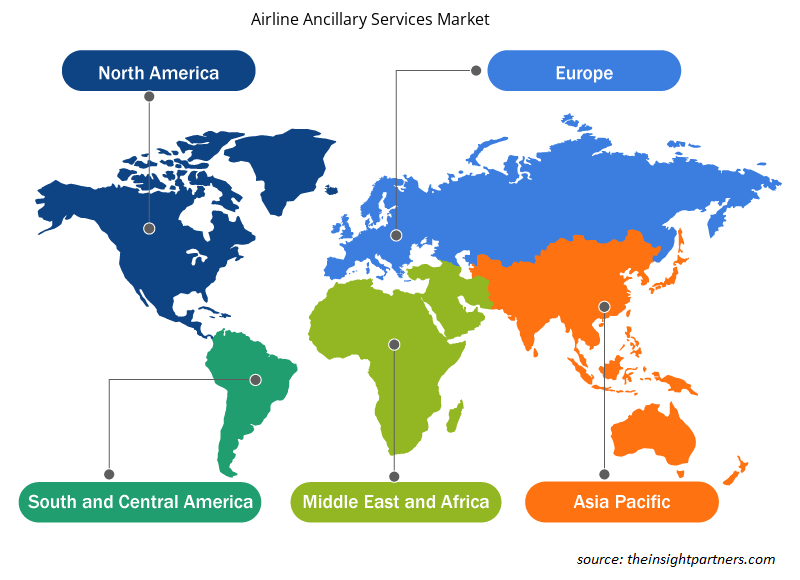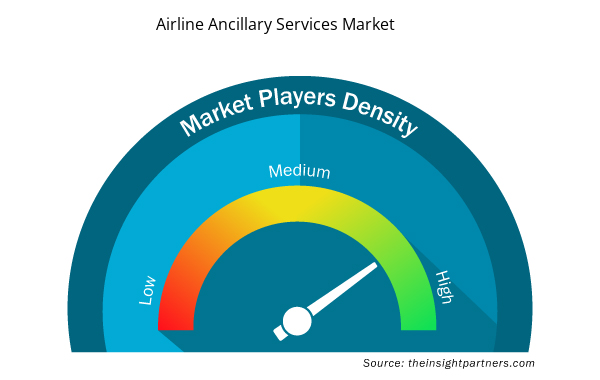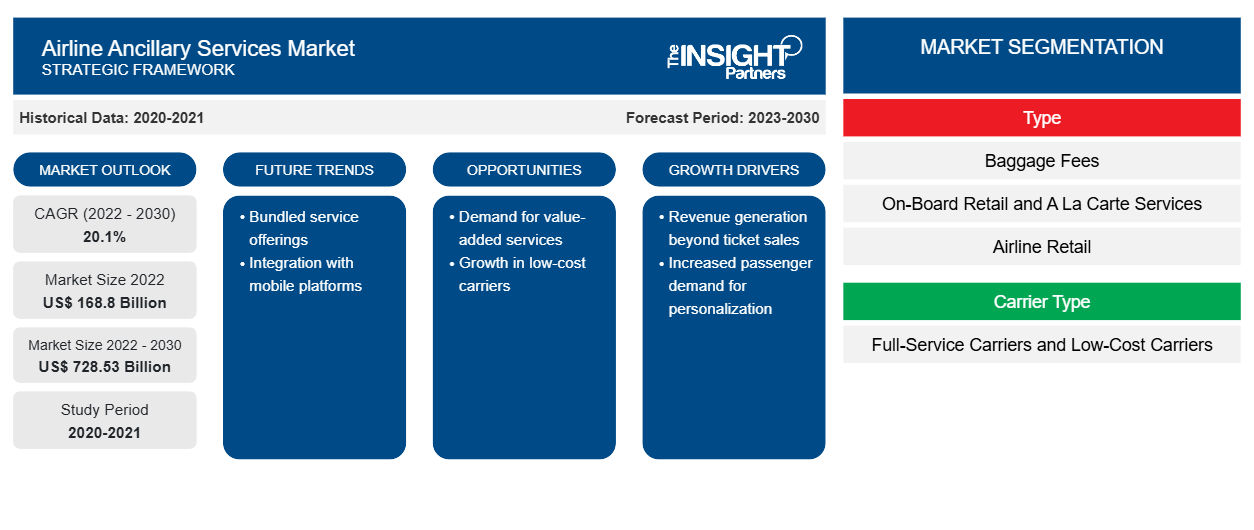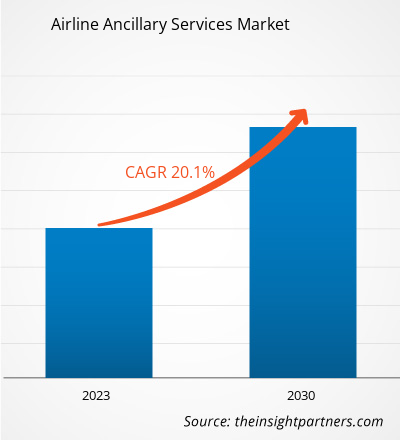[調査レポート] 航空会社の付帯サービス市場規模は、2022年の1,688億ドルから2030年には7,285.3億ドルに達すると予測されており、2022年から2030年にかけて市場は20.1%のCAGRを記録すると予想されています。
アナリストの視点:
航空会社の付帯サービス市場で活動する主要企業は、エンターテイメント、Wi-Fi、ケータリングなどのサービスに対する需要の増加を目の当たりにしています。世界中の航空旅客数の増加は、航空会社の付帯サービス市場を大きく牽引しています。付帯収入は航空会社のビジネスモデルにとって重要です。たとえば、北米やヨーロッパなどの先進市場では、ライアンエア、スピリット、アリージャンスなどの航空会社は、付帯収入が総収入に大きく貢献していることを認識しています。この傾向はすぐにアジア太平洋の急速に発展している経済圏に取り入れられ、エアアジアなどの航空会社は、収入の5分の1が付帯サービスから得られていることを経験しました。したがって、この傾向は、特に発展途上国で航空会社の収入に大きな影響を与えると予想され、航空会社の付帯サービス市場の成長にさらに貢献するでしょう。
航空会社付帯サービス市場の概要:
航空会社の付帯サービス市場は、乗客が自分の体験に付加価値をもたらすサービスに対して喜んでお金を払うことから恩恵を受けています。座席のアップグレード、座席の事前予約、手荷物などは、需要のある人気の付帯サービスです。これらの変化するニーズに応えるため、いくつかのスタートアップ企業が市場に参入しています。さらに、格安航空会社は世界の航空業界で大きな重要性を増しています。発券、空港サービス、機内サービスなどの堅牢なビジネスモデルにより、格安航空会社はあらゆる階層の乗客を引き付けることができます。機内での食事や飲み物のサービス、Wi-Fi、小売などの追加サービスに対する乗客の需要の高まりは、スタートアップ企業にさまざまな機会を提供することが期待されています。前述の付帯サービスとは別に、機内エンターテイメント(IFE)サービスが航空会社の付帯サービス業界に大きな影響を与えると予想されています。デジタル文化を身に付けた顧客、特にビジネス旅行者は、航空会社が機内での接続オプションを促進することを期待しています。また、短距離路線の乗客の大半は、搭乗時にデジタル機器にアクセスするためにウェブアクセスを希望していることも判明しました。そのため、IFE の需要が高まることで付帯収入が増加し、航空会社の付帯サービス市場の成長にプラスの影響を与えることが期待されます。
要件に合わせてレポートをカスタマイズする
このレポートの一部、国レベルの分析、Excelデータパックなど、あらゆるレポートを無料でカスタマイズできます。また、スタートアップや大学向けのお得なオファーや割引もご利用いただけます。
- このレポートの主要な市場動向を入手してください。この無料サンプルには、市場動向から見積もりや予測に至るまでのデータ分析が含まれます。
航空会社付帯サービス市場の推進要因:
中所得層の航空旅行の嗜好の高まり
国際航空運送協会(IATA)によると、飛行機で旅行する乗客の数は2036年までに約78億人に達すると予想されています。急速に台頭している中流階級は、発展途上国における航空旅客数の増加と関連している可能性があります。2021年10月、国連世界観光機関(UNWTO)や国際民間航空機関などの世界機関は、旅行と観光の復活を支援するために提携しました。2020年10月、UNWTOとIATAは、世界的な観光の再開を支援するために協力するための覚書を締結しました。この合意の主な焦点は、一般大衆の航空旅行に対する信頼を高めることであり、これにより航空交通量がさらに増加しました。国連によると、特に中国とインドにおける中流階級の旅行者の増加は、航空旅行とさまざまな付随サービスの成長に貢献する主な要因です。世界が経済収縮から回復するにつれて、航空旅行の需要が増加します。航空旅行の需要の高まりにより、航空機の生産量が増加し、機内Wi-Fi、超過手荷物、飲食物、機内ショッピングなどの付帯サービスの需要に大きく貢献しています。航空旅客へのサービス向上への重点が高まり、世界中の航空旅客数が増加していることが、航空付帯サービス市場の成長を牽引しています。
航空会社付帯サービス市場のセグメント分析:
航空会社の付帯サービス市場は、タイプ別に、手荷物料金、機内販売とアラカルト、航空会社販売、FFPマイルセール、その他に分類されています。手荷物料金セグメントは、2022年に最大の市場シェアを占めました。手荷物料金は、航空会社が手荷物をチェックインしたり、フライトで追加の手荷物を運んだりするために課す追加料金です。これらの料金は基本航空券の価格とは別であり、航空会社、目的地、手荷物の重量やサイズなどの要因によって異なります。手荷物料金は航空業界で一般的な慣行となっており、航空会社は追加収益を生み出し、乗客により柔軟な運賃オプションを提供できます。旅行者は、受託手荷物の料金を支払うか、機内持ち込み手荷物のみで旅行する場合はより低い基本運賃を選択することができます。手荷物料金の導入は、航空会社の付帯サービス市場の重要な側面であり、航空会社に収益性を高める手段を提供し、乗客に旅行体験の選択肢を提供しています。
航空会社付帯サービス市場の地域分析:
北米の航空会社付帯サービス市場規模は2022年に6,470万米ドルで、2023年から2030年にかけて年平均成長率20.6%を記録し、2030年までに2億8,934万米ドルに達すると予想されています。北米の航空会社付帯サービス市場は、米国、カナダ、メキシコに分かれています。2022年、北米の航空会社付帯サービス市場で最大のシェアを占めたのは米国でした。経済分析局のデータによると、2022年度第4四半期の米国のGDPは約2.6%増加しました。このGDPの伸びは、主に堅調な企業投資と消費者支出によるものです。航空業界は、米国全体の経済成長に大きく貢献しています。民間航空部門における消費者支出と企業投資の増加は、航空会社付帯サービス市場の成長を促進すると予想されます。
航空会社付帯サービス市場の主要プレーヤー分析:
ユナイテッド航空ホールディングス、アメリカン航空グループ、デルタ航空、イージージェット、ルフトハンザドイツ航空、カンタス航空、ライアンエアー・ホールディングス、サウスウエスト航空、エミレーツ航空、エールフランス-KLMは、航空付帯サービス市場の主要企業です。
航空会社付帯サービス市場の地域別洞察
予測期間を通じて航空付帯サービス市場に影響を与える地域的な傾向と要因は、Insight Partners のアナリストによって徹底的に説明されています。このセクションでは、北米、ヨーロッパ、アジア太平洋、中東、アフリカ、南米、中米にわたる航空付帯サービス市場のセグメントと地理についても説明します。

- 航空関連サービス市場の地域別データを入手
航空会社付帯サービス市場レポートの範囲
| レポート属性 | 詳細 |
|---|---|
| 2022年の市場規模 | 1,688億米ドル |
| 2030年までの市場規模 | 7,285.3億米ドル |
| 世界のCAGR(2022年 - 2030年) | 20.1% |
| 履歴データ | 2020-2021 |
| 予測期間 | 2023-2030 |
| 対象セグメント | タイプ別
|
| 対象地域と国 | 北米
|
| 市場リーダーと主要企業プロフィール |
|
航空会社の付帯サービス市場のプレーヤー密度:ビジネスダイナミクスへの影響を理解する
航空会社の付帯サービス市場は、消費者の嗜好の変化、技術の進歩、製品の利点に対する認識の高まりなどの要因により、エンドユーザーの需要が高まり、急速に成長しています。需要が高まるにつれて、企業は提供内容を拡大し、消費者のニーズを満たすために革新し、新たなトレンドを活用し、市場の成長をさらに促進しています。
市場プレーヤー密度とは、特定の市場または業界内で活動している企業または会社の分布を指します。これは、特定の市場スペースに、その市場規模または総市場価値に対してどれだけの競合相手 (市場プレーヤー) が存在するかを示します。
航空付帯サービス市場で事業を展開している主要企業は次のとおりです。
- ユナイテッド航空ホールディングス
- アメリカン航空グループ
- デルタ航空
- イージージェット
- ルフトハンザドイツ航空
免責事項:上記の企業は、特定の順序でランク付けされていません。

- 航空会社付帯サービス市場のトップキープレーヤーの概要を入手
最近の動向:
航空会社の付帯サービス市場の企業では、合併や買収などの無機的および有機的な戦略が広く採用されています。航空会社の付帯サービス市場における最近の主要な動向をいくつか以下に示します。
- ユナイテッド航空は2023年2月、小さなお子様連れのご家族が追加料金なしで隣の座席を選択できるようにする決定を発表しました。この顧客に優しい措置は、ご家族にシームレスで快適な旅行体験を提供することの重要性を認識したものであり、ユナイテッド航空が付帯サービスを強化することに注力していることを強調しています。
- デルタ航空は2023年1月、T-Mobileとの提携により、米国の乗客に無料Wi-Fiを提供すると発表しました。2月1日より、スカイマイルのマイレージプログラム会員は無料Wi-Fiを利用できるようになります。この動きは、付帯サービス提供の強化に向けた大きな一歩であり、機内体験の向上と忠実な顧客への付加価値に対するデルタ航空の取り組みを示しています。
- イージージェットは2022年7月、夏の旅行シーズンに向けて一連の取り組みを実施し、顧客体験の向上に努めました。これには、家族向けの専用顧客ホットライン、顧客サービス時間の延長、主要空港での「ヘルピングハンズ」、トワイライトバッグドロップサービスの再導入などが含まれます。同航空会社は、乗客にさらなるサポートと利便性を提供することを目指しており、付帯サービスの強化への取り組みを示しています。
- 過去2年間の分析、基準年、CAGRによる予測(7年間)
- PEST分析とSWOT分析
- 市場規模価値/数量 - 世界、地域、国
- 業界と競争環境
- Excel データセット



Report Coverage
Revenue forecast, Company Analysis, Industry landscape, Growth factors, and Trends

Segment Covered
This text is related
to segments covered.

Regional Scope
North America, Europe, Asia Pacific, Middle East & Africa, South & Central America

Country Scope
This text is related
to country scope.
よくある質問
The key players holding majority shares in the Global Airline Ancillary Services Market are United Airlines Holdings Inc, American Airlines Group Inc, Delta Air Lines Inc, EasyJet Plc, and Deutsche Lufthansa AG.
The rising preference for air travel by middle-income passengers, benefits of frequent flyer programs, and in-flight retail partnerships are the major factors that propel the Global Airline Ancillary Services Market.
Increasing deployment of in-flight wi-fi are impacting the Global Airline Ancillary Services, which is anticipated to play a significant role in the Global Airline Ancillary Services Market in the coming years.
The Global Airline Ancillary Services Market is expected to reach US$ 728.53 billion by 2030.
The incremental growth expected to be recorded for the Global Airline Ancillary Services Market during the forecast period is US$ 559.73 billion.
The Global Airline Ancillary Services Market was estimated to be US$ 168.80 billion in 2022 and is expected to grow at a CAGR of 20.1% during the forecast period 2023 - 2030.
Trends and growth analysis reports related to Aerospace and Defense : READ MORE..
The List of Companies - Airline Ancillary Services Market
- United Airlines Holdings Inc
- American Airlines Group Inc
- Delta Air Lines Inc
- EasyJet Plc
- Deutsche Lufthansa AG
- Qantas Airways Ltd
- Ryanair Holdings Plc
- Southwest Airlines Co
- The Emirates
- Air France KLM SA
The Insight Partners performs research in 4 major stages: Data Collection & Secondary Research, Primary Research, Data Analysis and Data Triangulation & Final Review.
- Data Collection and Secondary Research:
As a market research and consulting firm operating from a decade, we have published and advised several client across the globe. First step for any study will start with an assessment of currently available data and insights from existing reports. Further, historical and current market information is collected from Investor Presentations, Annual Reports, SEC Filings, etc., and other information related to company’s performance and market positioning are gathered from Paid Databases (Factiva, Hoovers, and Reuters) and various other publications available in public domain.
Several associations trade associates, technical forums, institutes, societies and organization are accessed to gain technical as well as market related insights through their publications such as research papers, blogs and press releases related to the studies are referred to get cues about the market. Further, white papers, journals, magazines, and other news articles published in last 3 years are scrutinized and analyzed to understand the current market trends.
- Primary Research:
The primarily interview analysis comprise of data obtained from industry participants interview and answers to survey questions gathered by in-house primary team.
For primary research, interviews are conducted with industry experts/CEOs/Marketing Managers/VPs/Subject Matter Experts from both demand and supply side to get a 360-degree view of the market. The primary team conducts several interviews based on the complexity of the markets to understand the various market trends and dynamics which makes research more credible and precise.
A typical research interview fulfils the following functions:
- Provides first-hand information on the market size, market trends, growth trends, competitive landscape, and outlook
- Validates and strengthens in-house secondary research findings
- Develops the analysis team’s expertise and market understanding
Primary research involves email interactions and telephone interviews for each market, category, segment, and sub-segment across geographies. The participants who typically take part in such a process include, but are not limited to:
- Industry participants: VPs, business development managers, market intelligence managers and national sales managers
- Outside experts: Valuation experts, research analysts and key opinion leaders specializing in the electronics and semiconductor industry.
Below is the breakup of our primary respondents by company, designation, and region:

Once we receive the confirmation from primary research sources or primary respondents, we finalize the base year market estimation and forecast the data as per the macroeconomic and microeconomic factors assessed during data collection.
- Data Analysis:
Once data is validated through both secondary as well as primary respondents, we finalize the market estimations by hypothesis formulation and factor analysis at regional and country level.
- Macro-Economic Factor Analysis:
We analyse macroeconomic indicators such the gross domestic product (GDP), increase in the demand for goods and services across industries, technological advancement, regional economic growth, governmental policies, the influence of COVID-19, PEST analysis, and other aspects. This analysis aids in setting benchmarks for various nations/regions and approximating market splits. Additionally, the general trend of the aforementioned components aid in determining the market's development possibilities.
- Country Level Data:
Various factors that are especially aligned to the country are taken into account to determine the market size for a certain area and country, including the presence of vendors, such as headquarters and offices, the country's GDP, demand patterns, and industry growth. To comprehend the market dynamics for the nation, a number of growth variables, inhibitors, application areas, and current market trends are researched. The aforementioned elements aid in determining the country's overall market's growth potential.
- Company Profile:
The “Table of Contents” is formulated by listing and analyzing more than 25 - 30 companies operating in the market ecosystem across geographies. However, we profile only 10 companies as a standard practice in our syndicate reports. These 10 companies comprise leading, emerging, and regional players. Nonetheless, our analysis is not restricted to the 10 listed companies, we also analyze other companies present in the market to develop a holistic view and understand the prevailing trends. The “Company Profiles” section in the report covers key facts, business description, products & services, financial information, SWOT analysis, and key developments. The financial information presented is extracted from the annual reports and official documents of the publicly listed companies. Upon collecting the information for the sections of respective companies, we verify them via various primary sources and then compile the data in respective company profiles. The company level information helps us in deriving the base number as well as in forecasting the market size.
- Developing Base Number:
Aggregation of sales statistics (2020-2022) and macro-economic factor, and other secondary and primary research insights are utilized to arrive at base number and related market shares for 2022. The data gaps are identified in this step and relevant market data is analyzed, collected from paid primary interviews or databases. On finalizing the base year market size, forecasts are developed on the basis of macro-economic, industry and market growth factors and company level analysis.
- Data Triangulation and Final Review:
The market findings and base year market size calculations are validated from supply as well as demand side. Demand side validations are based on macro-economic factor analysis and benchmarks for respective regions and countries. In case of supply side validations, revenues of major companies are estimated (in case not available) based on industry benchmark, approximate number of employees, product portfolio, and primary interviews revenues are gathered. Further revenue from target product/service segment is assessed to avoid overshooting of market statistics. In case of heavy deviations between supply and demand side values, all thes steps are repeated to achieve synchronization.
We follow an iterative model, wherein we share our research findings with Subject Matter Experts (SME’s) and Key Opinion Leaders (KOLs) until consensus view of the market is not formulated – this model negates any drastic deviation in the opinions of experts. Only validated and universally acceptable research findings are quoted in our reports.
We have important check points that we use to validate our research findings – which we call – data triangulation, where we validate the information, we generate from secondary sources with primary interviews and then we re-validate with our internal data bases and Subject matter experts. This comprehensive model enables us to deliver high quality, reliable data in shortest possible time.


 このレポートの無料サンプルを入手する
このレポートの無料サンプルを入手する